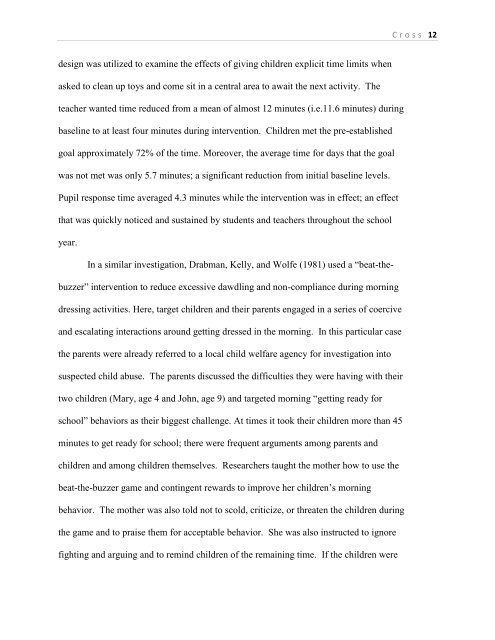THE EFFECTS OF A TIMER AND MYSTERY MOTIVATORS ON THE ...
THE EFFECTS OF A TIMER AND MYSTERY MOTIVATORS ON THE ...
THE EFFECTS OF A TIMER AND MYSTERY MOTIVATORS ON THE ...
Create successful ePaper yourself
Turn your PDF publications into a flip-book with our unique Google optimized e-Paper software.
C r o s s 12<br />
design was utilized to examine the effects of giving children explicit time limits when<br />
asked to clean up toys and come sit in a central area to await the next activity. The<br />
teacher wanted time reduced from a mean of almost 12 minutes (i.e.11.6 minutes) during<br />
baseline to at least four minutes during intervention. Children met the pre-established<br />
goal approximately 72% of the time. Moreover, the average time for days that the goal<br />
was not met was only 5.7 minutes; a significant reduction from initial baseline levels.<br />
Pupil response time averaged 4.3 minutes while the intervention was in effect; an effect<br />
that was quickly noticed and sustained by students and teachers throughout the school<br />
year.<br />
In a similar investigation, Drabman, Kelly, and Wolfe (1981) used a “beat-thebuzzer”<br />
intervention to reduce excessive dawdling and non-compliance during morning<br />
dressing activities. Here, target children and their parents engaged in a series of coercive<br />
and escalating interactions around getting dressed in the morning. In this particular case<br />
the parents were already referred to a local child welfare agency for investigation into<br />
suspected child abuse. The parents discussed the difficulties they were having with their<br />
two children (Mary, age 4 and John, age 9) and targeted morning “getting ready for<br />
school” behaviors as their biggest challenge. At times it took their children more than 45<br />
minutes to get ready for school; there were frequent arguments among parents and<br />
children and among children themselves. Researchers taught the mother how to use the<br />
beat-the-buzzer game and contingent rewards to improve her children’s morning<br />
behavior. The mother was also told not to scold, criticize, or threaten the children during<br />
the game and to praise them for acceptable behavior. She was also instructed to ignore<br />
fighting and arguing and to remind children of the remaining time. If the children were
















